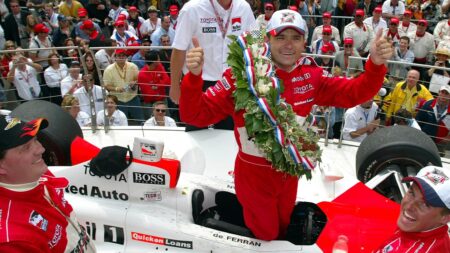“But when I did that 241 qualifying lap the car was perfect. I remember feeling everything through my hands. Going into turn one I was telling myself, ‘Don’t lift! Don’t lift!’ You’ve just gotta believe in the car because on a big oval, if you wait to feel that the grip is there, it’s too late. So there’s a big commitment factor. You’ve got to throw yourself in there, particularly in qualifying, because the grip changes with the air temperature and humidity.
“As soon as I crossed the start/finish line they said over the radio, ‘You’ve got pole!’ At the time the most significant thing was getting pole and the point that went with it, because we were fighting for the championship.
“The record was great but at the time it didn’t seem very important to me. But as the years have gone by it’s changed. I think it was pretty cool we were able to make that record under racing conditions. A lot of record attempts are done in special conditions away from a race weekend. As far as accomplishments go, that is one I’m very proud of.”
The other ‘record’
Mauricio Gugelmin points out that in practice prior to his ’97 record qualifying run he turned a lap at 242.333mph. “The unofficial record is still mine. That’s the fastest lap ever, I guess.”
Gugelmin echoes de Ferran’s remarks about coping with the car. “What you had to watch was getting up to that speed, because the car was very stiffly sprung with no downforce and plenty of power,” he says. “Once you were running at that speed every single input had to be minute because it was very easy to lose control. You were basically on a wire.
“You had to be as smooth as you could and then just hold your breath for a couple of laps”
“To get the car up to that high level of speed was almost like doing a perfect qualifying lap on a street circuit. It was like flying a jet. You had to make sure your head was way ahead of it.
“At home I have one of my old cars from those days and a poster of that lap where [engineer] Andy Brown did the throttle traces and the steering input. It’s amazing to look at because you hardly put any lock on the wheel. You just had to turn it very lightly and you could reduce the speed by 7mph, from your terminal speed to your apex speed, just because the front wheels were turning ever so slightly.
“Fontana was a new track and we were running fast right away. We were probably 7 or 8mph off [the limit] but we kept trimming the wings. I had one set of tyres that had a tremendous vibration. A wheel that was a bit out of balance became a big problem at those speeds. The car had to be perfect and all the bodywork had to be carefully taped with no air leaks anywhere. You had to be as smooth as you could and then just hold your breath for a couple of laps. But it was a great feeling.”

Gugelmin and engineers produced a car that flew “like a jet”
Daimler-Benz
Many fans agree that CART’s turbocharged Indycars from that era, in Superspeedway trim with tiny front and rear wings, were some of the most elegant single-seaters ever seen, as well as some of the most demanding to drive.
“I’d been driving Indycars for five years by then,” says de Ferran. “It didn’t matter how many times you [drove them], there was so much power it took a few laps to get your foot and your eyes and hands all in order.
“Some people couldn’t get on with them because they had so much power. On the road courses you touched the throttle and it really responded. The public knew that car I qualified at Fontana was a very difficult car to drive. It was a beast!”



